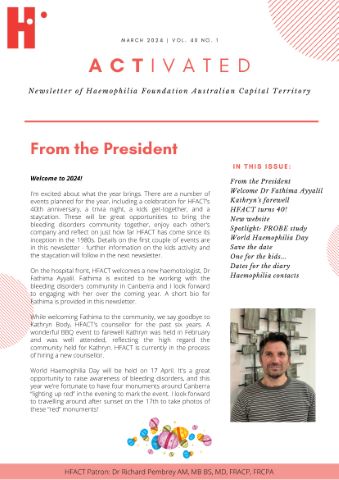Belinda spoke with HFA about her journey to tackle life independently with factor X (10) deficiency.

It’s the goal of many young people to leave home and see the world. But taking charge of your life to achieve this can have its challenges, especially you have a rare clotting factor deficiency.
Belinda was diagnosed with factor X deficiency as a newborn when she had the routine heel prick test and her mother noticed that it didn’t stop bleeding. Neither of her two older brothers had a bleeding disorder and it was later found that there was no family history as well.
Factor X deficiency occurs in 1 in a million people and Belinda has the severe form. ‘I describe it by saying my blood doesn’t clot at all,’ she said.
SPEAKING UP
Growing up with a very rare health condition involved watching her mother advocate and learning that she would need to speak up for herself. Even in large cities many health professionals have never had a patient with a rare clotting factor deficiency. When she was younger Belinda lived in a remote outback town. ‘Things have changed now but in those days factor X deficiency was sometimes described as a type of haemophilia,’ explained Belinda. ‘At times the hospital staff didn’t believe Mum, because “only boys have haemophilia’’!’
TESTING BOUNDARIES

‘During my teenage years I felt very isolated and had no connection with anyone else like me. I hated having to have factor treatment and knowing I had to do it all the time. And every time I had a period, I needed a double dose. So I got to a point in my teens where I would push the boundaries with my treatment and then get a bleed.’
Her parents understood that she needed to test the waters and try things out for herself.
‘My parents were amazing. They never bubble-wrapped me – the only thing I wasn’t allowed to do was ride motorbikes.’
MANAGING TREATMENT
Infusing her treatment was a struggle for Belinda. For most of her life this has involved injecting the treatment into a port, a small device surgically implanted under the skin, usually the chest.
‘My veins are pretty shocking and so at a young age I got a port, something I still have today. My mum was infusing me at home, which was great, but it didn’t give me any independence as she was the only one that could do it. I never thought I could leave Mum, but I was determined to learn to infuse myself via the port and become independent. By the time I was 18 I could infuse myself. I was able to leave home and move to the big city and travel the world, something I had wanted to do for so long and did do successfully.’
Treatment is still an area where she feels vulnerable.
‘My biggest fear is losing the port as I cannot infuse into my veins. Last year I got an infection in the port from a wound on my arm. I was able to get rid of the infection and get a new port, but I was very worried during that time.’
RELATIONSHIPS
Like many young people with bleeding disorders, Belinda treats her personal relationships carefully and thinks about when to tell new potential partners and how.
‘Meeting new people is always a dilemma. On a first date they might see my scars and ask about them. I live with a wonderful housemate who knows all about my bleeding disorder and understands where I am coming from.’ For Belinda, this means being in control of when she tells someone new about her bleeding disorder. ‘We have ensured that all my supplies are in a separate fridge and not on show.’
CONNECTING TO OTHERS
Connecting to other people with bleeding disorders is important to Belinda. She started going to Foundation community camps when she was 16 years old and joined the local foundation committee as a young adult.

What are Belinda’s tips for other young people with bleeding disorders?
- Reach out for support
- Be part of your local foundation, attend functions and camps
- Work at becoming independent – and you may need to figure out how to do some things yourself
- Don’t let your bleeding disorder stop you (within reason!)


